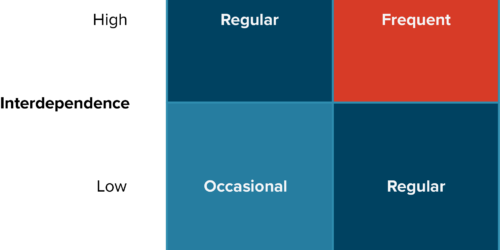Why meet? Understanding the Function of Meetings in the Collaborative Workplace
When we work in collaboration with other people, we have two things we have to take care of to be successful.
The work and the people.
In theory, the work should be something we can plan and manage logically. After each piece of work begins, there are a series of tasks to complete and problems to solve that continue on until the work is done.
Also in theory, the people doing the work should be able to coordinate their efforts through a simple exchange of factual information. When Fred completes task A, he marks it done, and Betty starts task B. When Alan runs into a problem with the work, he could write down the facts of the situation and send them to others for help – help they could then offer in any number of ways that do not involve a team meeting.
Clean, efficient, and logical. When the work is well understood and routine, this approach makes sense. The people doing the work click along like a “well-oiled machine”.
In these situations, there is very little reason to meet.
Of course, the “well-oiled machine” theory of work only applies to jobs that could literally be replaced by one or more well-oiled machines. The order of tasks, environment in which the tasks are performed, and definition of success are all known in advance. The context and the players rarely change, everyone knows what they’re supposed to do, and they just get on with it.
When the definition of the work doesn’t change, everyone involved has a shared perspective on the work that does not change.
Few businesses are that static. The well-oiled machine theory doesn’t apply to businesses that need to respond, adapt, evolve, and grow.
The well-oiled machine theory does not apply to collaborative work.
This theory is also just crap when you have to work with people, because people aren’t machines that simply receive input and spit out company value. All that “human capital” businesses “leverage” is made up of a host of individual people who’ve all got their own thing going on.
So, because they’re human, when Fred completes task A, he may indeed mark it done. But let’s say Betty’s cousin is in town and she’s taking a few days off, so she doesn’t start task B right away. Then, when she gets back she finds 239 new alerts in her inbox and never even sees the note from Fred. The machine breaks down. Later, when Alan runs into that tricky problem with the work, instead of writing it up so the team can help, he spends the first day thinking that he must be an idiot and Googling for answers. When that doesn’t work, he picks up a few side tasks to keep himself busy, hoping a solution will “come to him” while he’s getting other stuff done. It doesn’t, and now it’s been days and other things are starting to stack up behind Alan’s unfinished assignments. Again, the machine breaks down.
This team needs to meet.
Why Teams Meet
Meetings have one function.
We meet to quickly create shared perspective in a group.
Let’s pull that statement apart, starting with the concept of a “shared perspective”.
Before the meeting, we call the shared perspective we want to create the “desired outcome”. Desired outcomes take many forms; the outcome of a meeting can be a decision, a plan, a commitment, a new understanding, an intention, an apology, a resolution, and so on.
When they meet, Fred and Betty will figure out that it’s time for her task to begin. If they meet soon enough, Alan will have to share the problem he ran into, giving the rest of the team a chance to either help him or adjust their plans around him before the whole project goes totally out of whack.
The shared perspective created in a meeting doesn’t just include what the group agrees to on a pragmatic basis. It also includes what they now know or believe that they didn’t before, and how they feel about the whole thing.
When Fred, Betty, and Alan meet, they get a shared perspective on the work – what’s done, what’s not – and the people. Fred will learn that Betty isn’t ignoring him, and they can both stop assuming that Alan’s a slacker.
Meetings put focus on both the work and the people.
The coaches at Leadership Strategies describe meeting outcomes in terms of the “Hand, Head, and Heart.” They teach us to think through what each person should leave the meeting with “in their hand” – the tangible or documented result, “in their head” – new knowledge and understanding, and “in their heart” – meaning how we hope people will feel at the meeting’s end.
As many people have pointed out, though, there are other ways to create shared perspective. Email, reports, books, chat, video can all work – and we certainly can’t just meet with all the people all the time when we want to communicate our thoughts and feelings. Given all the alternatives, why meet at all?
The key is in the word “quickly”. Meetings quickly create shared perspective. When well executed, the other adjective I’d add is “reliably”, as no other communication tool gives you the same level of clarity and control that a meeting can.
Let’s take a look at our mental model to help illustrate that point.
Direction, Momentum, and Force:
A Visual Model for Understanding Meeting Function
At Lucid, we have a mental model we use when designing and running meetings. After looking at Anders Ericsson’s Peak: Secrets from the New Science of Expertise, I’ve been fascinated by how important and useful having a mental representation can be.
In this case, I find it’s easiest to understand what meetings do for teams with some simple visuals.
In the diagrams below, the little half-domes represent the people on the team.
Before the very first meeting, the people are all out there just doing their own thing.
In the meeting, they come together to explore the work at hand.
After the meeting, they leave with a shared perspective on the work and begin to move in a coordinated way towards a common goal.
Most meetings last less than one hour. On the overall work timeline, an hour is a blink.
This is where the “quickly” part of our meeting function shines. Meetings quickly create shared perspective in a group.
By contrast, when we look at how long it takes for a team to get coordinated by email, our only guarantee that the total elapsed time required is less than an hour is if we have each one constantly checking email. That doesn’t bode well for their chances of getting much else done, does it? Most tasks require periods of uninterrupted focus; something group chat and email aren’t designed to respect.
The Function of a Meeting
Because all the people start in different places, effective meetings start by focusing the group and bringing them in to the conversation.
Once the group is focused, they can move into the main part of the meeting.
Storming, forming, and norming. Divergent, emergent, convergent. These formalisms are ways of describing what happens between a group of people in a meeting as they explore and align their unique perspectives.
The path the conversation takes during the meeting depends on the desired outcome; it can get pretty messy while all those individual perspectives navigate their way to a mutually understood and agreed outcome.
Then, once this desired outcome is achieved, an effective meeting ends with a clear and focused review of the result.
You can visualize the meeting as a force that pulls people together, gets them aligned, then pushes them towards a shared goal.
Why Teams Have Lots of Meetings
In a perfectly harmonious and stable world, our team could meet just once to get that shared perspective, then happily flow down that straight path to done. Well-oiled machine and all that.
That is not the world we live in, so naturally that never happens, and we need more meetings. If we visualize the meetings scheduled for a typical project on a timeline, it might look something like this.
(Note: I’m using the term “project” here to represent any goal-oriented work a group might undertake. The same concept applies whether your team writes standards, builds products, drives corporate strategy, or hosts an annual bake sale.)
With our pull-push visual in mind, we can zoom-in on this timeline to look at what’s happening with the team at the beginning of the project.
Like we saw before, that first meeting pulls the group together and sends them out on the path. But this time, we can see that while all the people are headed in basically the same direction, they’re not all moving at the same speed or at quite the same angle.
In other words, they are people with all their individual skills and quirks and realities. So, before too long, the team has another meeting to pull that group back into alignment.
And this pattern repeats until the work reaches a conclusion.
For teams working towards a common goal, meetings are a forcing function for creating alignment around a shared perspective.
Unlike email or chat or project records, meetings are hard to ignore. When team members are headed in wildly different directions, or someone is off in la-la-land, a meeting can bring them all together much more quickly and effectively than any other method.
Assuming it’s a decent meeting, of course. But that’s a topic for another day.
(OK, specifically, we’ll talk about this in the next post.)
Meeting Strategy: Knowing When to Meet
I’ve written in the past about when not to meet – about when to cancel a meeting rather than waste everyone’s time. Now let’s look at when you should meet, based on this understanding of what meetings do for our teams and our work.
When to Meet Rule 1: Meet to Create Momentum
In between meetings, a team’s sense of shared perspective gets fuzzier as each person learns new things, then encounters distractions, obstacles, and competing priorities.
When meetings are fairly close together, there isn’t much time for people to get too far off the path. Re-creating that shared perspective is pretty easy.
It’s just a little pull back into alignment.
But the longer you wait between meetings, the more frayed that shared perspective gets.
Those who move quickly have a chance to get way out ahead of the group. Those with slower motors get farther and farther behind. Some get lost, and there’s always a risk that someone has been completely knocked out by some outside factor.
All of which may go unnoticed by the rest of the group in that big gap between meetings. The people on this team are no longer looking at the work from the same angle.
In some ways, this group is farther apart than they were before the project started. The second meeting now needs to be just as long and involved as the first one in order to re-create shared perspective.
So mind the gap!
Schedule meetings frequently enough to maintain momentum.
How frequent is frequent enough? We’ve been researching this topic and share our findings in the post on Meeting Cadence. Hint: it’s probably not what you think it is!
When to Meet Rule 2: Meet to Change Course
So far we’ve been focusing mostly on how meetings help us create a shared perspective between people. Sometimes, however, it’s not the people who get out of alignment, but the work itself that goes all wonky.
We live in a dynamic universe, and sometimes elements out of our control come in and blow our best laid plans to smithereens.
When facing an unexpected dead-end, teams meet to re-orient themselves and chart a new path. What just happened? What do we do now? How do we get back on track? Important questions that the team needs a shared perspective on answering before they can move forward.
Catastrophes aren’t the only changes that warrant a meeting.
More often than not, the path that seemed so clear at the outset gets complicated along the way. The team may find itself at a crossroads, unsure which path will lead to the goal most directly. Other times, the team may glimpse an alternate route leading to an entirely new destination – one that they couldn’t see before they started along this path.
Whenever a team is faced with a major change in how to proceed, meet.
What constitutes a “major” change?
Obviously that depends, but I think it’s helpful to remember rule 1:
Meet to Create Momentum.
Any change of course that the team must have shared perspective around, and where a lack of shared perspective would be a momentum killer, warrants a meeting.
Take-Aways
To sum up:
- Meetings are a collaboration tool used to quickly create shared perspective.
- Meetings function by pulling a group of people together, creating alignment around their work, and pushing them out along a coordinated path towards a goal.
- Meetings must be held frequently enough to maintain this shared perspective and create momentum along the path.
- Meetings should be held any time the path becomes unclear, and the whole team needs to shift to a new perspective on the work.
Putting the Mental Model to Work
Like all mental models, this one is an oversimplification. Hopefully, though, a useful one. If this has resonated with you and you incorporate this model into how you approach meetings going forward, two things will happen.
First, you’ll become radically focused on meeting outcomes. You’ll know what a meeting is supposed to achieve for a team, and quickly recognize when you’re in a meeting that isn’t doing the job.
Second, you’ll see when you need to meet with your team, and when a meeting is a waste of time. With an understanding of how this pull-push dynamic works to create momentum on a project, you may even find yourself scheduling more meetings than before.
(Speaking of which: the next post in this series covers how to structure meetings that work, giving you a framework for planning effective business meetings.)
Finally, feedback, comments and suggested improvements are most welcome! Did you find this useful? How can it be improved? Please share!
This post is the second in a six-part series exploring what it takes for companies to run consistently worthwhile meetings.
- Introduction: Creating A Foundation for Changing Your Organization’s Meetings
- This post! Meeting Strategy: Why meet? Understanding the Function of Meetings in the Collaborative Workplace
- Meeting Execution: The Underlying Structure of Meetings that Work
- Meeting Cadence: How often should you meet? Selecting the right meeting cadence for your team
- Meeting Design: How to Create Standard Agendas for Your Business
- Meeting Performance Maturity: How to evolve meeting performance across the organization



